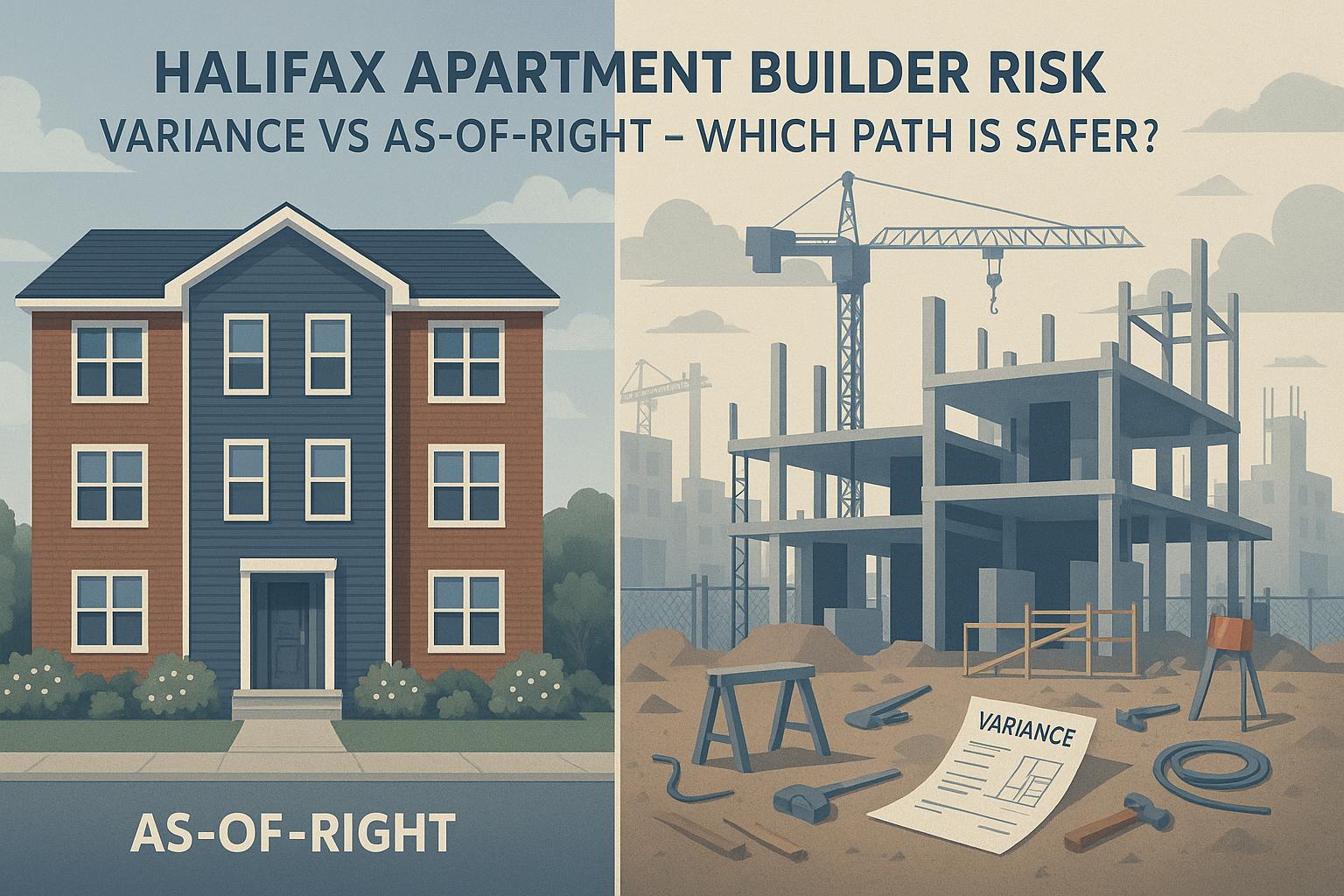Nova Scotia's rental properties face unique weather challenges, from hurricanes to heavy snowfall, making storm-resistant construction essential for property owners. By focusing on durable roofing, well-sealed walls, flood-resistant foundations, and reliable mechanical systems, you can protect your investment, lower repair costs, and provide safer housing for tenants.
Key Takeaways:
- Roof Design: Steep gable roofs and reinforced connections withstand high winds and snow loads.
- Walls & Windows: Fibre cement cladding, impact-resistant windows, and proper sealing prevent water damage and improve energy efficiency.
- Foundation Protection: Effective drainage, sump pumps, and waterproofing guard against flooding.
- Mechanical Systems: Backup power, ductless heat pumps, and smart monitoring systems ensure comfort and safety during storms.
Investing in storm-resistant features not only safeguards your property but also keeps rental income steady and reduces long-term maintenance headaches.
3 Details For Framing in Storm Zones
Roof Construction: Handling Wind and Snow Loads
Nova Scotia's harsh storms put your roof to the test. A well-thought-out design and strong structural connections can be the difference between minor fixes and a total rebuild.
Roof Shapes That Resist Wind
A roof with a 6/12 pitch or steeper, especially a straightforward single-ridge gable design, is ideal for shedding snow and reducing load risks. These simple designs perform better than complex rooflines with valleys or dormers, which can trap snow and increase the strain on the structure. If your home has a curved roof built before the 1995 National Building Code, it might lack the support needed to handle uneven snow loads, making it less suitable for Nova Scotia's challenging weather. Whatever the design, ensuring the roof is securely fastened to the building is non-negotiable.
Structural Connections and Reinforcement
Strong roof-to-wall connections are essential for standing up to storms. Using hurricane straps or clips to attach each rafter or truss to the wall plates helps keep the roof firmly in place during high winds. This simple yet effective reinforcement not only boosts the structure's durability but also enhances safety for those inside.
In areas prone to heavy snowfall, additional reinforcements are crucial to handle the extra weight and drifting snow. Roof trusses must be properly anchored, and with climate change influencing weather patterns, the National Building Code of Canada (NBCC) 2025 is adjusting regional design loads to reflect these new realities. To prepare for these changes, work with engineers familiar with the NBCC 2025 updates to ensure your building is ready for future conditions.
While the current building code sets minimum snow load requirements, designing beyond these standards can make your roof even more resilient against Nova Scotia's unpredictable weather.
Walls, Windows, and Doors: Weather Protection Systems
After securing a durable roof, the next step in storm protection is creating a well-sealed envelope with walls, windows, and doors. A strong building envelope is essential to keep storm damage at bay.
Weather-Resistant Wall Systems
When it comes to wall materials, fibre cement cladding stands out. It handles temperature changes and impacts far better than vinyl or wood. However, proper installation is key. Using stainless steel fasteners is a smart choice, especially in coastal areas, as they resist corrosion, even if they come at a higher price.
For added strength and energy efficiency, consider double sheathing. By combining rigid foam insulation with standard OSB sheathing, you create a thermal break that reduces heat loss and improves tenant comfort. This approach also minimizes thermal bridging, which can otherwise lead to energy inefficiencies.
Another critical aspect is addressing wall penetrations. Flashing around all openings ensures water is directed away from the structure. For windows and doors, step flashing is more reliable than caulking, which can fail with time. Using peel-and-stick membrane flashing in these areas provides a dependable seal that can handle the natural movement of the building.
Once the walls are secure, it’s time to focus on windows and doors to complete the weatherproofing.
Storm-Rated Windows and Doors
In regions like Nova Scotia, where strong winds and flying debris are common, impact-resistant windows are a must. Look for windows with high design pressure ratings to ensure they can handle heavy wind loads without compromising their seal.
Triple-pane, low-E windows are another excellent choice. The extra glass layer adds durability, while the low-emissivity coating keeps heat inside during colder months. These windows are designed to maintain their performance even after repeated exposure to temperature changes.
When selecting frames, fibreglass outperforms vinyl in areas with fluctuating temperatures. Fibreglass expands and contracts at a similar rate to glass, reducing the risk of seal failure, which can lead to fogging or air leaks. While fibreglass windows may have a higher upfront cost, their durability often makes them a better long-term investment.
For entry doors, steel doors with insulated foam cores provide better impact resistance and superior thermal performance compared to hollow-core options.
Proper installation is just as important as material choice. Windows and doors should be shimmed to ensure they’re level and square. After that, sealing with expanding foam before installing trim helps prevent air leaks, reducing condensation and energy costs.
These steps, combined with comprehensive sealing, ensure the entire building envelope remains protected.
Air and Water Sealing
A continuous air barrier is crucial to stop the stack effect, where cold air is drawn into the building, and warm, moist air escapes into wall cavities. Materials like house wrap or rigid foam sheathing can create an effective barrier, but only if seams are taped and penetrations are sealed properly.
In Nova Scotia’s climate, the placement of vapour barriers is especially important. Installing plastic sheeting on the warm side of the insulation prevents moisture from reaching cold surfaces where it could condense. The barrier must remain uninterrupted - gaps, even small ones, can allow moisture to seep through.
Sealing openings with membranes and tapes is also essential. Features like a sloped sill pan help direct water away from windows and doors, while flexible flashing tape at corners addresses common leakage points. For added protection, back-damming the sill can further prevent water from tracking into the structure during heavy rain.
Regular upkeep is key. For example, polyurethane caulks stay flexible in cold weather better than acrylic ones, and EPDM rubber weatherstripping holds its seal longer than foam alternatives.
Lastly, the building’s drainage system must efficiently shed water at every level. Overlapping each protective layer - like shingles on a roof - ensures water is directed away from the structure. If water does get past the outer layer, it should drain out through weep holes rather than pooling in wall cavities.
sbb-itb-16b8a48
Foundations and Water Management: Flood Protection
Nova Scotia's climate brings unique challenges, including heavy rainfall, significant snowmelt, and coastal storms. For multi-unit rental properties, this means foundations must not only provide structural stability but also manage water effectively. Just like the building envelope, the foundation needs to be built to withstand the province’s extreme weather conditions.
Building a Flood-Resistant Foundation
A sturdy foundation is the first line of defence against water infiltration. Opt for foundation systems designed with water management in mind to limit the risk of water seeping into the structure.
Effective Drainage Solutions
Good drainage is critical to keeping water away from the foundation. This starts with proper site grading to ensure surface water naturally flows away from the building. Subsurface drainage, like well-installed French drains, can direct groundwater away from the foundation, reducing the risk of pooling.
Backup sump pump systems are another layer of protection, especially during heavy rains or floods, as they actively remove any water that accumulates. Roof drainage systems, including correctly sized gutters and downspouts, are equally important for quickly diverting stormwater away from the building. Incorporating permeable landscaping around the property can further help by reducing water runoff and allowing better absorption into the ground.
Waterproofing the Foundation
To create a strong barrier against water intrusion, apply external waterproofing membranes alongside interior protective measures. These systems should be checked and maintained regularly to ensure they continue to perform as intended. Regular upkeep is key to keeping the foundation dry and intact despite Nova Scotia’s unpredictable weather.
Mechanical and Energy Systems for Storm Reliability
When Atlantic storms knock out power in Nova Scotia, the strength and dependability of your rental property's mechanical and energy systems become vital. These systems not only help keep tenants safe and comfortable but also work alongside the building's structural defences to ensure a well-rounded approach to storm resilience. While roofs, walls, and foundations keep the elements out, reliable mechanical systems ensure essential services continue without interruption. Designing these systems with storms in mind means balancing uninterrupted service during outages with year-round energy efficiency.
Backup Power Systems
Storm-related power outages can range from a few hours to several days. A solid backup power plan should first cover life-safety essentials like emergency lighting, fire alarms, sump pumps, and heating systems before addressing tenant comfort.
Battery backups work well for short outages, while natural gas generators are better suited for extended disruptions. These generators should be sized specifically for critical systems to avoid unnecessary energy use.
Solar panels combined with battery storage can offer a renewable backup option, though winter conditions may limit their effectiveness. To ensure reliability during colder months, pair solar systems with an alternative backup source.
Position generators and solar panels above known flood levels to protect them from water damage. Once electrical continuity is secured, focus on maintaining efficient climate control for tenant comfort.
Efficient Heating and Cooling
Given Nova Scotia's long heating season, dependable heating is a top priority for tenant satisfaction. Ductless heat pumps are an energy-efficient choice, even in cold climates. Modern systems designed for colder conditions maintain efficiency during harsh weather, helping to keep operating costs down while making your property more appealing to renters.
For backup heating, consider options like natural gas fireplaces or wood stoves in select units to provide warmth when electrical systems fail.
Zoned heating systems give tenants control over individual room temperatures, reducing energy waste and improving comfort. Smart thermostats with battery backups ensure programmed settings remain intact during brief outages, allowing for a smooth transition when power returns. With heating and power secured, intelligent monitoring systems can further protect your property from potential issues.
Smart Monitoring Systems
Installing water sensors near sump pumps, water heaters, and basements can provide instant alerts for leaks or flooding, enabling timely intervention.
Automatic utility shutoffs add another layer of protection. For instance, gas shutoff valves can activate during system malfunctions to prevent hazardous leaks, while water shutoffs triggered by leak sensors can minimise damage when immediate action isn’t possible.
Remote monitoring systems let you oversee building performance from anywhere. You can track unit temperatures, sump pump activity, generator performance, and overall power consumption in real time. This insight helps you address urgent issues quickly, especially during storms.
Smart electrical panels take efficiency a step further by offering real-time power monitoring and automatically shutting off non-essential loads during backup power use. This extends generator runtime and prevents overloading. Some systems even restart equipment in stages after power is restored, avoiding damage from sudden surges.
Temperature monitoring is especially crucial during winter storms. Falling indoor temperatures can lead to frozen pipes, which can cause significant damage. Setting alerts for low-temperature thresholds allows you to act before pipes freeze, protecting your property from costly repairs.
Building Storm-Resistant Rental Properties That Last
Constructing storm-resistant rental properties is a smart way to protect your income, keep maintenance costs steady, and ensure tenant safety. The key to success lies in coordinating all building systems seamlessly. By focusing on resilient design principles and using an integrated approach, many common construction challenges can be avoided.
Disjointed coordination among contractors often leads to budget overruns of 30–60% and can drag an eight-month project out to 18 months or more. For true storm resistance, every element - whether it’s the roof, foundation, windows, or power backup - needs to work together, not just individually, especially under extreme weather conditions.
An integrated design-build approach solves these issues by consolidating all professionals into one team. This ensures that all components function as a cohesive system. The financial upside? Property owners can save up to $47,000 by eliminating coordination inefficiencies. Plus, fixed-price construction removes the risk of unexpected costs, and projects are delivered on time. For example, a typical fourplex generating $8,800 in monthly rent can start earning income as planned.
Quality control is another strength of this approach. Instead of relying on individual contractors to inspect their own work, professional engineers carry out multiple inspections throughout the build. This rigorous process, paired with a two-year warranty, ensures that storm-resistant features will perform when Atlantic storms hit.
Beyond cost savings, an integrated schedule keeps construction efficient. Advanced planning tools can cut a typical 12- to 18-month timeline down to just six months. This means you can start collecting rent faster while reducing the risk of weather-related delays. Features like daily photo updates and real-time monitoring also let you stay informed without needing to visit the site constantly.
For property owners in Nova Scotia, this approach delivers tangible benefits. Rental units can achieve $1,950–2,100 per month in rent, with annual returns on investment ranging from 12–20%. By minimizing maintenance issues and enhancing tenant satisfaction, your investment stays secure, even as poorly coordinated properties struggle to keep up.
FAQs
Why is an integrated design-build approach ideal for constructing storm-resilient rental properties in Nova Scotia?
An integrated design-build approach works exceptionally well for creating storm-resilient rental properties. Why? Because it ensures that features tailored to the local climate - like reinforced foundations, weather-resistant roofing, and efficient drainage systems - are thoughtfully planned and executed right from the start. This proactive planning not only avoids expensive adjustments down the line but also helps build homes that can better handle Nova Scotia's harsh weather conditions.
By having one team oversee both the design and construction phases, this method simplifies the process. It eliminates the hassle of juggling multiple contracts, improves accountability, and accelerates project timelines. The outcome? Sturdy, weather-ready properties that reduce maintenance costs and place tenant safety front and centre for years to come.
How do impact-resistant windows and doors improve a building's ability to withstand storms?
Impact-resistant windows and doors are essential for shielding buildings during severe weather conditions. Built to handle strong winds and flying debris, they help prevent breakage and keep the building's structure intact. By avoiding breaches, these features protect both the property and the people inside from potential harm.
On top of that, these sturdy additions can lead to lower maintenance expenses over time. For property owners and tenants in storm-heavy areas like Nova Scotia, they also offer a sense of security and reassurance.
How can mechanical and energy systems be designed to stay reliable during severe weather in Nova Scotia?
To keep mechanical and energy systems dependable during Nova Scotia's harsh weather conditions, it’s crucial to implement storm-resilient designs and use materials suited to the region’s unique climate. This means reinforcing electrical grids to endure hurricanes and Nor’easters, adding backup power systems, and upgrading infrastructure to minimize outages.
Some effective steps include installing flood-resistant equipment, fortifying transmission lines, and creating systems capable of withstanding extreme winds and storm surges. These efforts not only boost reliability but also improve safety and lower maintenance expenses over time.
Related Blog Posts
- Building on the Nova Scotia Coast: How to Design and Construct Durable Seaside Home
- Building for Nova Scotia’s Climate: Weather-Proofing Your New Home
- Building a Winter-Ready Home in Nova Scotia: Design Tips for Harsh Weather
- Building Resilient Coastal Homes in Nova Scotia: Storm-Proof and Future-Ready



